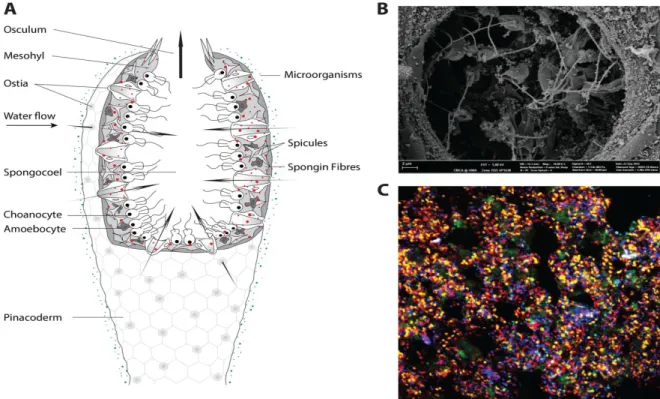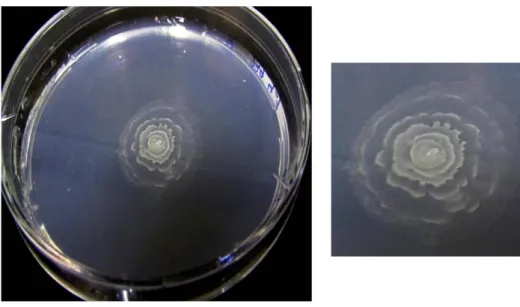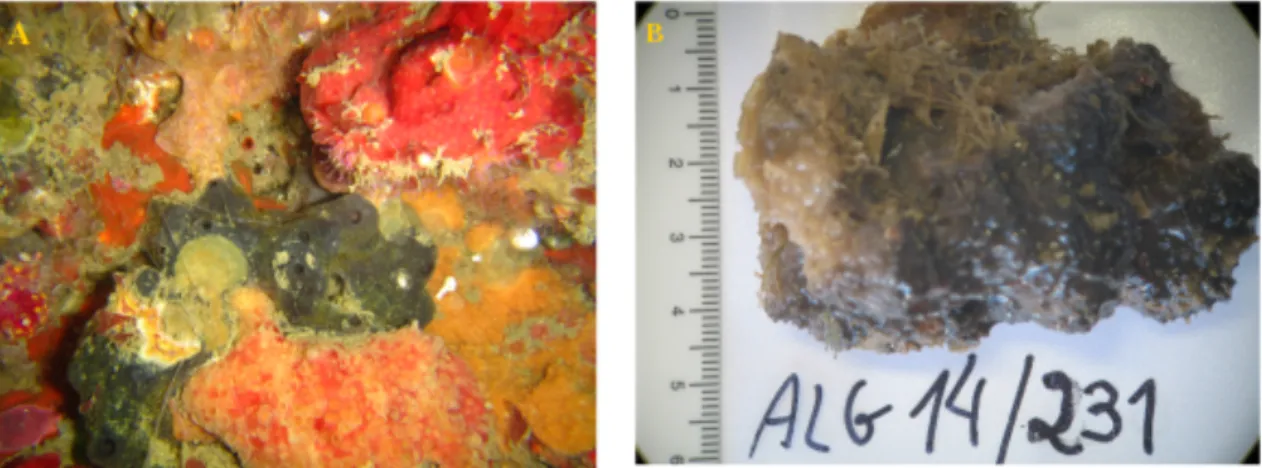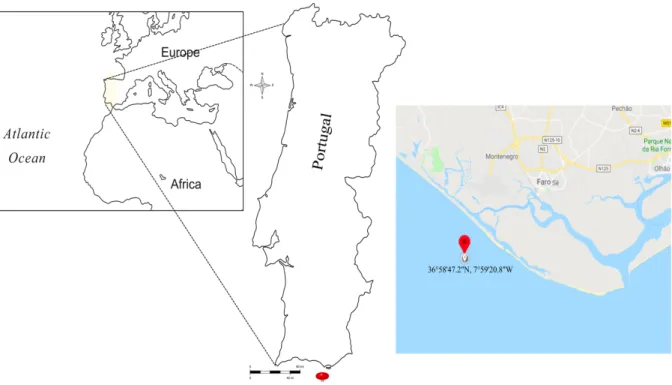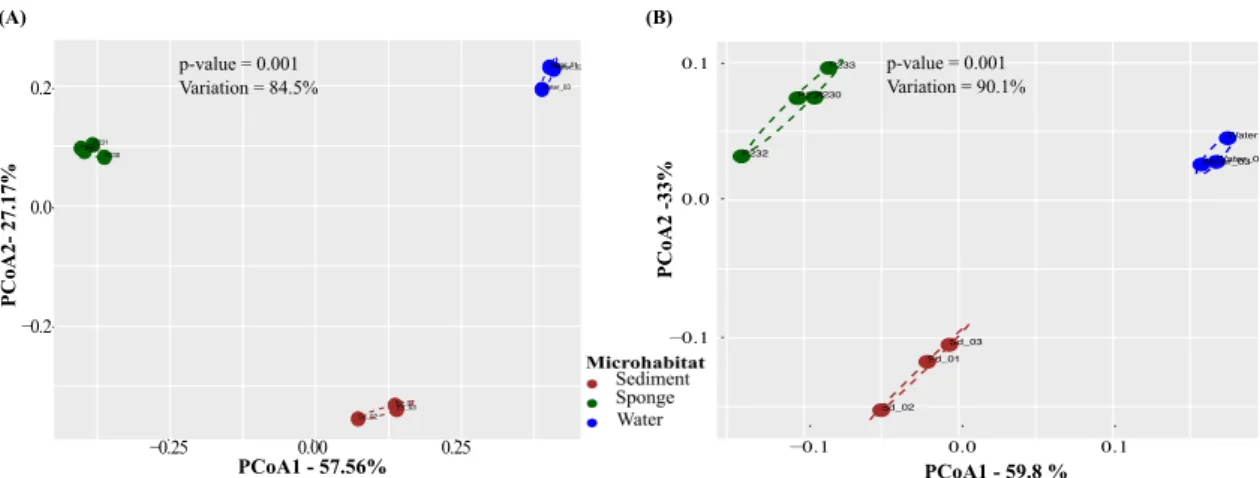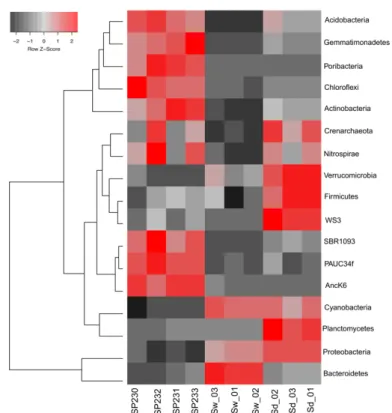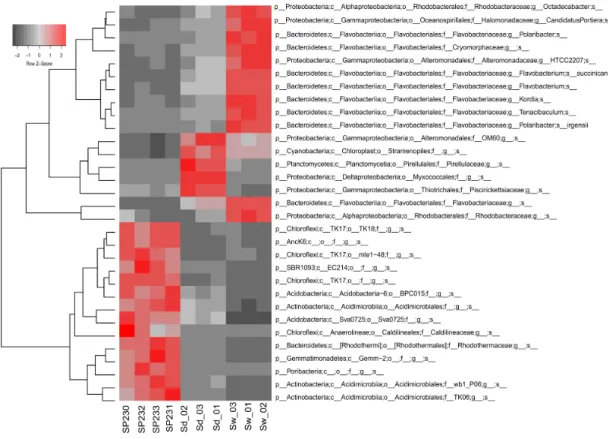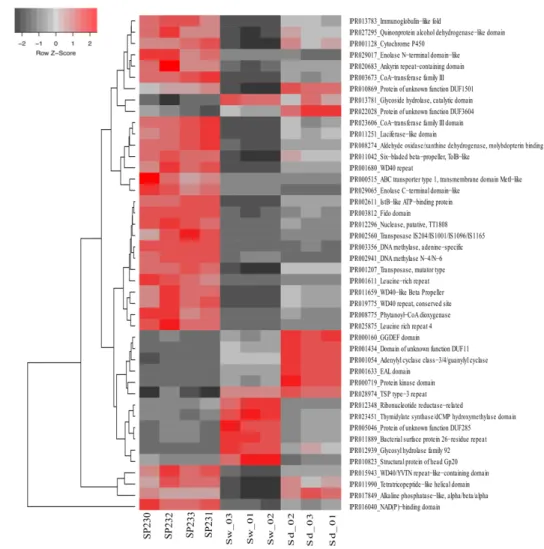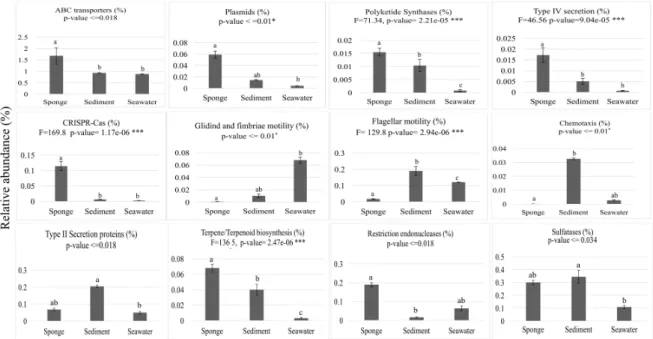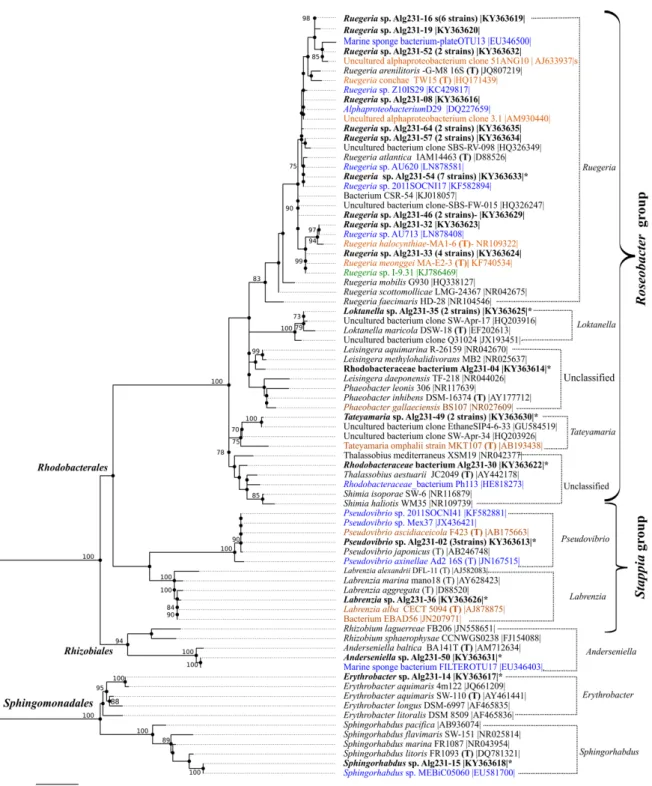Metagenomics and functional genomics of bacterial
symbionts of Spongia (Porifera, Dictyoceratida)
specimens from the Algarvian shore
(South Portugal)
Doctorate in Marine, Earth and Environmental Sciences (specialization in Marine Microbial Ecology)
Supervised by: Prof. Dr. Rodrigo da Silva Costa Prof. Dr. Maria Margarida dos Prazeres Reis
“Metagenomics and functional genomics of bacterial symbionts of Spongia (Porifera, Dictyoceratida) specimens from the Algarvian shore (South Portugal)”
This work has not previously been submitted for a degree in any university. To the best of my knowledge, the thesis contains no material previously published or written by another person except where due reference is made in the thesis itself.
---
©2018 Elham Karimi
The University of Algarve has the perpetual right with no geographical boundaries to archive and publicize this work through printed copies in paper or digitized, or in any other format known or that becomes invented, to broadcast through scientific repositories and to allow its copy and distribution with educational purposes for research, noncommercial, given that its author and editor are credited.
Elham Karimi was awarded an Erasmus Mundus Doctoral scholarship (SALAM) (EMA2 lot7/SALA1206422) to perform the work leading to this.
ACKNOWLEDGMENTS
I was awarded full scholarship support for pursuing my PhD by the Erasmus Mundus Programme (SALAM-lot7) and I am sure that completing this work would have been impossible without such a grant. Thanks to all people who have initiated and worked in this association for helping young science lovers to follow their dreams and passions.
I would also like to sincerely thank many people who made this PhD journey such a rewarding and growing experience.
I would like to greatly thank my supervisors, Prof. Dr. Rodrigo Costa for offering me the opportunity to work on this project and all invaluable advises throughout the thesis, and to Prof. Dr. Margarida Reis for accepting me in UAlg.
I am sincerely grateful to Prof. Dr. Ute Henstchel for hosting me for three months at GEOMAR-Germany and showing me different prospects of doing and collaborating in science. My special thanks to all co-authors and colleagues contributing in this project: Dr. Jorge M.S. Gonçalves, Dr. Joana R. Xavier, Miguel Ramos, Dr. Beate Slaby, Dr. Cymon Cox, André R. Soares, Dr. Tina Keller-Costa, Dr. Ulisses N. da Rocha, and Dr. Jochen Blom.
While I was working in the lab with the group MicroEcoEvo in CCMAR, I had a great chance to meet nice people who hadn’t hesitated to help. I am greatly thankful to Telma Franco for her spectacular help, to Marta Valente for providing excellent Sangar sequencing services. I am also thankful to Gianmaria Califano for his help in the lab at the very beginning of my PhD journey.
I gratefully acknowledge the Research funding grant from FEMS for supporting my stay in Germany to perform part of this project. I would like to thank the Research Unit Marine Microbiology at the Division of Marine Ecology, GEOMAR at Kiel-Germany for all warm hosting and great discussion through seminars and lectures. I learned a lot from you all. Also, thanks to people in institute for Biotechnology and Bioengineering (IBB-IST) in Lisbon for all warm smiles when I had meetings with my supervisor there.
Had I not met decent people; Beate, André, Tabea, and Miguel; this journey would not have been valuable at all. You were wonderful people I met on this journey.
Last but most importantly, many thanks to my husband, Alireza, who has been staying beside me from the beginning of this journey with all unconditional help and love, and big thanks to my family; Maman, Baba, Elahe, Ehsan, Neda and little Artin whom I have always got energy of them from a distance, encouraging me to be patient and hardworking.
ABSTRACT
Sponges are early-branched, filter-feeding metazoans that usually harbor complex microbial communities comprised of diverse “uncultivable” symbiotic bacteria. In this thesis, the functional and taxonomic features of the marine sponge microbiome are determined, using Spongia officinalis as model host organism. Emphasis is given to adaptive and functional traits of the profuse and biotechnologically-relevant alphaproteobacterial symbionts of sponges. A metagenomics-centred approach was employed to reveal microbial taxa and genomic signatures enriched in the Spongia officinalis endosymbiotic consortium, and thus likely to play pivotal roles in holobiont functioning. Further, a comparative genomics study is presented unveiling the common and specific traits of ten Alphaproteobacteria genera isolated from S. officinalis with alternative symbiont cultivation methodology. Finally, a sequence composition-dependent binning approach is employed to assemble, from metagenomic sequences, the genome of an uncultured alphaproteobacterial symbiont of S. officinalis belonging to the family Rhodospirillaceae.
High abundance of polyketide and terpene synthase-, eukaryotic-like protein- (ELPs), type IV secretion system-, plasmid- and ABC transporter-encoding genes, among others, characterized the sponge microbial metagenomes. In contrast, motility and chemotaxis genes were abundant in seawater and sediment microbiomes, but nearly absent in the S. officinalis symbiotic consortium. Much higher frequencies of anti-viral CRISPR-Cas and restriction-modification systems, along with much lower viral abundances, were observed in the sponge-associated metagenomes than in the environment and interpreted as true hallmarks of this symbiotic consortium.
In line with outcomes retrieved for the whole symbiotic community, alphaproteobacterial symbionts of marine sponges likely contribute the most to host fitness through nutritional exchange, cell detoxification processes and chemical defense, the latter being theoretically promoted by both polyketide and terpenoid biosynthesis. The several alphaproteobacterial cultures retrieved in this thesis, displaying high natural product biosynthesis capacities, can now be explored in studies aiming at revealing novel biological activities and chemical structures from these symbionts.
Keywords
Porifera, metagenomics, functional genomics, Alphaproteobacteria, host-microbe interactions, microbiome.
RESUMO
As esponjas marinhas (filo Porifera) são consideradas um dos mais simples grupos entre os metazoários em função de sua falta de organização em tecidos e órgãos verdadeiros. Porém, estes animais relativamente simples em termos de plano corporal normalmente abrigam comunidades muito complexas de microorganismos. Em função de seu surgimento basal na história evolutiva do planeta, o conhecimento a respeito deste “holobionte”, isto é, o consórcio de organismos formado pela esponja marinha hospedeira e todos os seus simbiontes microbianos, possui grande relavância ao avanço da nossa compreensão sobre as interações hospedeiro-microorganismos. Nesta tese de doutoramento, tive como objetivo a determinação das características funcionais e taxonómicas do microbioma das esponjas marinhas no contexto de seu ambiente circundante (água e sedimentos marinhos, e suas respecticvas microbiotas), dando ênfase aos traços adaptativos e funcionais de alfaproteobactérias associadas ao organismo modelo Spongia officinalis (“bath sponge”). Para tal, uma abordagem independente de cultivo, centrada em técnicas de metagenómica, foi empregada para revelar grupos taxonómicos e genes microbianos abundantes no consórcio de endosimbiontes da esponja S.
officinalis e que, desta forma, provavelmente possuem papel importante no funcionamento e
homeostase do “holobionte” (Capítulo 2). Considerando (1) a abundância, diversidade e plasticidade metabólica de alfaproteobactérias marinhas, (2) a prevalência e ampla distribuição geográfica de alfaproteobactérias especificamente associadas a esponjas marinhas, até então não cultivadas em laboratório, e (3) o facto de que foi possível cultivar muitas estirpes filogeneticamente distintas de alfaproteobactérias associadas a S. officinalis através do uso de modificações simples a protocolos convencionais de cultivo bacteriano, o Capítulo 3 apresenta um estudo de genómica comparativa que revela os atributos funcionais comuns e específicos de dez géneros pertencentes à classe Alphaproteobacteria isolados de S. officinalis com o emprego de metodologia alternativa. Finalmente, o Capítulo 4 descreve a utilização de uma abordagem bioinformática de “genomic binning”, centrada na composição de nucleótidos, para possibilitar a assemblagem, a partir de sequências metagenómicas do microbioma de S.
officinalis obtidas no Capítulo 2, de um genoma de uma alfaproteobactéria não cultivada em
laboratório, pertencente à família Rhodospirillaceae. Desta forma, esta tese combina abordagens dependentes e independentes de cultivo visando a obtenção de um conhecimento mais amplo acerca das características genómicas verdadeiramente promovidas no consórcio simbiótico das esponjas marinhas, e revela os traços adaptativos, potencial codificador e as
prováveis funções da complexa comunidade de alfaproteobactérias que habita estes hospedeiros.
A anotação de metagenomas microbianos (Capítulo 2) revelou que a comunidade simbiótica de S. officinalis distinguiu-se fortemente das comunidades microbianas em água e sedimentos marinhos através de uma maior abundância de linhagens bacterianas até então não cultivadas pertencentes aos filos Proteobacteria, Poribacteria, Actinobacteria,
Gemmatimonadetes, Chloroflexi e Acidobacteria. No filo Proteobacteria, várias unidades
taxonómicas operacionais (OTUs, estabelecidas a 97% de semelhança do gene 16S rRNA) pertencentes às famílias Rhodobacteraceae e Rhodospirillaceae foram prevalentes nos metagenomas microbianos associados à esponja. Uma alta frequência de genes codificadores de policetídeo-sintases, terpeno-sintases, “eukaryotic-like proteins” (ELPs, p.ex. repetições de sequências de anquirina, tetratricopéptidos e elementos WD40), sistemas tipo IV, plasmídeos, transportadores do tipo ABC e luciferases, entre outros, foi registada no metagenoma microbiano das esponjas. Interessantemente, as comunidades microbianas do sedimento abrigaram maior abundância residual destes (e muitos outros) elementos genéticos claramente “enriquecidos” (ou seja, de maior abundância) nas esponjas marinhas em comparação com as comunidades microbianas da água. Porém, abundâncias muito mais altas de genes envolvidos com quimiotaxia e motilidade microbiana foram obtidas para as comunidades de água e sedimento em comparação com o consórico simbiótico em S. officinalis, onde tais elementos genéticos estiveram praticamente ausentes. Fez-se notar também a frequência muito mais alta dos elementos anti-virais “CRISPR-Cas” e de restrição-modificação (R-M), acompanhada por uma redução na abundância de vírus, nos metagenomas microbianos da esponja marinha em comparação com o seu ambiente circundante, e tais elementos foram interpretados como “assinaturas genómicas” fulcrais deste consórcio simbiótico. Em sua totalidade, estes resultados sugerem que, embora os microbiomas inspeccionados sejam altamente contrastantes em termos de taxonomia e função, maiores densidades de partículas e células - factores comuns aos microbiomas de sedimentos e esponjas marinhas - podem possuir algum papel na evolução de traços funcionais convergentes entre ambos. Considerou-se ainda que o consórcio simbiótico das esponjas é formado essencialmente por microorganismos sésseis com papel primordial na troca de nutrientes com o hospedeiro (especialmente no que diz respeito aos metabolismos de azoto e enxofre), além de possuírem mecanismos de defesa anti-viral altamente sofisticados em conjunto com uma alta capacidade de troca génica com outros microorganismos e com o organismo hospedeiro. Este últimos factores são dos que mais contribuem ao carácter verdadeiramente único desta comunidade simbiótica.
Em paralelo à análise metagenómica, uma plataforma alternativa ao cultivo de simbiontes bacterianos, calcada no uso de um meio oligotrófico (MG50) e temperaturas de incubação mais baixas, foi aplicada ao microbioma associado a S. officinalis e bem-sucedida no isolamento de uma alta diversidade de géneros de Alphaproteobacteria como, por exemplo,
Anderseniella, Erythrobacter, Labrenzia, Loktanella, Ruegeria, Sphingorhabdus, Tateyamaria, Pseudovibrio e dois prováveis novos géneros pertencentes à família Rhodobacteraceae (Capítulo 3). A comparação global dos genomas de todas as bactérias
mencionadas acima, e a detecção de genes comuns a todos os genomas, veio a demonstrar que a comunidade cultivável de alfaproteobactérias associadas a S. officinalis pode contribuir ao aumento do “fitness” do hospedeiro através de mecanismos de detoxificação (p. e.x. remoção de metais pesados e rejeitos metabólicos, degradação de compostos aromáticos e halogenados), fornecimento de vitaminas essenciais, troca de nutrientes (especialmente em relação ao processamento de enxofre e azoto orgánicos) e defesa química (em particular através da biossíntese de policetídeos e terpenóides, muito comum entre estes simbiontes). Em função do potencial codificador muitíssimo diversificado dos dez genomas analisados, foi empregada uma comparação genómica feita com base em anotações ao nível de COGs (“Clusters of Orthologous Groups of Proteins”) de forma a revelar padrões de convergência e divergência entre os vários genomas. Este procedimento revelou três grupos genómicos, posteriormente divididos em dois maiores grupos funcionais: genomas peretencentes ao clado Roseobacter (Grupo I, GI) versus genomas não pertencentes a este clado (Grupo II, G2). Concluiu-se que espécies representativas do Grupo II possuem maior probabilidade em estabelecer relações simbióticas mais próximas com as esponjas marinhas, em função de vários elementos genómicos, como genes codificadores de ELPs, proteínas de adesão e pili - usualmente considerados “factores de simbiose” -, que estiveram presentes em maior abundância nos genomas deste Grupo em comparação com o Grupo I. Particularmente, o género Anderseniella apresentou o repertório de traços genotípicos mais claramente associado a uma estratégia de vida simbiótica. Ainda assim, todos os organismos estudados não apresentaram sinais de redução genómica, usualmente considerados indicadores de um modo de vida simbiótico, e de facto possuem um metabolismo de utilização de fontes de carbono altamente versátil, o que sugere que a estratégia adaptativa destas bactérias é bifásica e portanto inclui ambos os estágios livre e de associação ao hospedeiro.
O Capítulo 4 apresenta um estudo em que sequências metagenómicas do microbioma de S. officinalis (Capítulo 2) foram utilizadas para reconstruir, através de plataformas sofisticadas de bioinformática, o genoma de um simbionte dominante neste hospedeiro, porém
não cultivado, pertencente à família Rhodospirillaceae. Em conjunção com a descrição do genoma obtido, uma abordagem de genómica comparativa foi implementada para determinar os elementos genéticos envolvidos com a adaptação de linhagens pertencentes a esta família a um modo de vida preponderantemente simbiótico. Isto foi alcançado através da determinação de genes significativamente mais/menos abundantes em grupos de genomas de
Rhodospirillaceae representativos de um modo de vida simbiótico versus um modo de vida
livre de associação a um hospedeiro (“free-living”). Embora ambos os grupos “simbiótico” e “livre” tenham partilhado muitos genes em comum e demonstrado metabolismo de aquisição e utilização de nutrientes (carbono, azoto, fósforo e enxofre) altamente versátil, os genomas “simbióticos” foram claramente caracterizados pela ausência de genes envolvidos em motilidade e quimiotaxia - de acordo com o observado no microbioma simbiótico “total” (Capítulo 2) -, por alta frequência de genes envolvidos com a utilização de enxofre orgánico, e por uma composição distinta de genes codificadores de trasnportadores ABC, metabolitos secundários, sistemas de detoxificação celular e regulação de estresse oxidativo. Em congruência com resultados obtidos para a comunidade simbiótica total (Capítulo 2) e muitos dos simbiontes cultivados (Capítulo 3), os simbiontes de esponja pertencentes à família
Rhodospirillaceae provavelmente contribuem mais significativamente ao metabolismo
hospedeiro através da troca de nutrientes, processos de detoxificação celular e defesa química, esta última teoricamente promovida pela biossíntese de policetídeos e terpenos. A obtenção, nesta tese, de diversas culturas de alfaproteobactérias potencialmente produtoras destes metaboitos, para além de outros produtos naturais vários, poderá ser explorada em estudos futuros com o objectivo de revelar novas actividades biológicas e estruturas químicas a partir destes simbiontes.
Para contextualizar o trabalho de investigação aqui realizado, e resumir os principais resultados obtidos e suas implicações aos campos da microbiologia de esponjas, interacção hospedeiro-microorganismos e biologia marinha, dois capítulos adicionais foram elaborados (Introducção e Discussão Geral, Capítulo 1 e Capítulo 5, respectivamente) e incorporados à estrutura da tese.
Termos chave
Porifera, metagenómica, genómica funcional, Alphaproteobacteria, interacções hospedeiro-microorganismo, microbioma.
ACKNOWLEDGMENTS ... I ABSTRACT ... III RESUMO ... V TABLE OF CONTENTS ... IX LIST OF FIGURES ... XIII LIST OF TABLES ... XV LIST OF ABBREVIATIONS ...XVI
GENERAL INTRODUCTION ... 1
PREFACE ... 3
MARINE SPONGE BIOLOGY AND ECOLOGY ... 4
MARINE SPONGES AND THEIR MICROBIAL COMMUNITIES ... 5
THE MICROBIOME OF DICTYOCERATIDA SPONGES FROM THE ALGARVE COAST ... 9
METAGENOMICS AS A TOOL TO UNDERSTAND MICROBIAL COMMUNITY STRUCTURE AND FUNCTION ... 12
RECONSTRUCTION OF GENOMES FROM METAGENOMES ... 13
CULTIVATION BIAS IN NATURAL ENVIRONMENTS AND STRATEGIES TO CULTIVATE THE UNCULTIVABLE ... 15
GENOME SEQUENCING AND COMPARATIVE GENOMICS TO IDENTIFY THE FUNCTIONAL FEATURES OF SYMBIONT GENOMES ... 17
AIMS AND SPECIFIC RESEARCH QUESTIONS ... 19
Cultivation-independent approaches to extract functional information from yet uncultivated bacterial symbionts ... 20
Alternative isolation and cultivation of sponge-associated bacteria ... 21
THESIS OUTLINE ... 23
COMPARATIVE METAGENOMICS REVEALS THE DISTINCTIVE ADAPTIVE FEATURES OF THE SPONGIA OFFICINALIS ENDOSYMBIOTIC CONSORTIUM ... 25
ABSTRACT ... 29
INTRODUCTION ... 30
MATERIALS AND METHODS ... 32
Sampling and sponge identification ... 32
Microbial metagenomic DNA extraction and Next-Generation Sequencing (NGS) ... 32
Metagenome data processing ... 33
Metagenome data analysis ... 34
Alternative analytical pipelines and data validation ... 35
Nucleotide sequence accession numbers ... 36
RESULTS... 36
Sponge identification... 36
Functional and taxonomic ordination ... 37
16S rRNA gene taxonomic profiling ... 39
IPR Functional profiling... 41
Functional conservation among Spongia officinalis and other sponge hosts ... 43
All domains-all genes taxonomic profiling using MG-RAST ... 44
DISCUSSION ... 45 SUPPLEMENTARY MATERIAL ... 53 ACKNOWLEDGMENTS... 53 FUNDING ... 53 CONFLICT OF INTEREST ... 53 ETHICS STATEMENT ... 53 AUTHOR CONTRIBUTIONS ... 53
FUNCTIONAL GENOMICS OF CULTIVATED SPONGE-ASSOCIATED ALPHAPROTEOBACTERIA REVEALS SHARED AND UNIQUE TRAITS UNDERLYING A BIMODAL SYMBIOTIC-FREE-LIVING LIFE-STYLE ... 55
ABSTRACT ... 59
INTRODUCTION ... 60
MATERIAL AND METHODS ... 62
Sample collection, cultivation of bacteria and phylogenetic analysis ... 62
Genome sequencing of sponge-associated Alphaproteobacteria ... 64
Annotation and comparative analysis of genomes ... 64
Representativeness of cultivated sponge-associated Alphaproteobacteria across marine biotopes ... 65
Nucleotide sequence accession numbers ... 65
RESULTS... 66
Isolation and identification of S. officinalis associated bacteria ... 66
General features of sponge-associated Aphaproteobacteria genomes ... 69
Core- and pan-genome analysis ... 69
Functional and comparative genomics based on Clusters of Orthologous Groups of Proteins (COGs) ... 71
Shared features of all genomes ... 72
Carbon, nitrogen, sulfur and phosphorus metabolism ... 72
Cofactors, vitamins and inorganic ions ... 72
Defense, antibiotic resistance and reactive oxygen species (ROS) protection ... 73
Eukaryotic-like proteins (ELPs) encoding genes ... 73
Roseobacter versus non-Roseobacter genome features ... 76
Secondary metabolism ... 78
Representation of the cultivated Alphaproteobacteria genomes in marine metagenomes ... 79
Embedded description of the Anderseniella sp. Alg231-50 genome ... 79
DISCUSSION ... 81
Communal metabolite features of cultivable sponge-associated Alphaproteobacteria ... 82
Antimicrobial agents ... 83
Representativeness of cultured Alphaproteobacteria in the marine sponge microbiome ... 84
Genome features of Anderseniella sp. Alg231-50 ... 86
SUPPLEMENTAL MATERIAL ... 87 ACKNOWLEDGMENTS... 87 FUNDING ... 87 CONFLICT OF INTEREST ... 87 ETHICS STATEMENT ... 87 AUTHOR CONTRIBUTIONS ... 87
METAGENOMIC BINNING REVEALS VERSATILE NUTRIENT CYCLING AND DISTINCT ADAPTIVE FEATURES IN ALPHAPROTEOBACTERIAL SYMBIONTS
OF MARINE SPONGES... 89
ABSTRACT ... 93
INTRODUCTION ... 94
MATERIALS AND METHODS ... 96
Sample collection, DNA extraction and sequencing... 96
Metagenome assembly ... 96
Genome binning from metagenomes ... 96
Genome annotation for comparative genomics ... 97
Phylogenomics of sponge-associated Alphaproteobacteria ... 98
Geographic distribution of uncultivated, sponge-associated Rhodospirillales ... 98
Genome features and life strategy of Rhodospirillaceae sponge symbionts ... 99
Nucleotide sequence accession numbers ... 100
RESULTS... 100
Phylogenomics of sponge-associated Alphaproteobacteria and relatives... 100
Core- and pan-genomes of sponge-associated and free-living Rhodospirillaceae ... 102
Functional genomics of sponge-associated and free-living Rhodospirillaceae ... 105
Adaptations to (sponge) symbiotic and free-living life-styles ... 109
DISCUSSION ... 113 SUPPLEMENTARY DATA ... 118 ACKNOWLEDGEMENTS ... 118 FUNDING ... 118 ETHICAL STATEMENT... 118 AUTHOR CONTRIBUTIONS ... 118
GENERAL DISCUSSION AND OUTLOOK ... 119
GENERAL DISCUSSION ... 121
Comparative metagenomics reveals unique life strategies of the Spongia officinalis endosymbiotic consortium (Chapter 2) ... 123
The Alphaproteobacteria symbiotic community in S. officinalis - a comparative and functional genomics approach ... 125
Genomes from cultivated bacteria ... 125
Genome reconstruction of a sponge-specific Rhodospirillaceae symbiont ... 127
CONCLUSIONS ... 129
FUTURE PERSPECTIVES ... 132
APPENDICES ... 135
APPENDIX I CHAPTER 2 COMPLEMENTARY ANALYSIS AND SUPPLEMENTARY MATERIALS ... 137
File S1 Preliminary data analyses and data validation with alternative analytical pipelines . 139 Supplementary Figures and Tables ... 144
APPENDIX II CHAPTER 3 SUPPLEMENTARY MATERIALS ... 147
Supplementary Figures ... 149
Supplementary Tables ... 151
APPENDIX III CHAPTER 4 COMPLEMENTARY ANALYSIS AND SUPPLEMENTARY MATERIALS ... 153
File S1 Data analysis ... 155
Supplementary Methods ... 155
Supplementary Results ... 156
Supplementary Figures and Tables ... 157
LIST OF FIGURES
FIGURE 1-1. (A) SCHEMATIC OVERVIEW OF AN ASCONOID SPONGE BODY PLAN. (B) SCAN ELECTRON MICROSCOPE (SEM) PICTURE OF MICROBES NEAR THE CHOANOCYTE CHAMBER.(C) FLUORESCENT IN SITU HYBRIDIZATION OF DIFFERENT MICROBIAL GROUPS IN THE SPONGE MESOHYL (PORIBACTERIA, YELLOW CELLS; NITROSPIRA, PINK CELLS; CHLOROFLEXI, CYAN CELLS; DELTAPROTEOBACTERIA, LIGHT
(DELTAPROTEOBACTERIA, LIGHT GREEN CELLS;GAMMAPROTEOBACTERIA, RED CELLS;ARCHAEA, BLUE CELLS).
SOURCE:WEBSTER AND THOMAS (2016). ... 11
FIGURE 1-2. AN ALPHAPROTEOBACTERIUM ISOLATED FROM SPONGIA (GROWING ON R2A MEDIUM) –
CULTIVATION AND PHOTO BY E.KARIMI. ... 17
FIGURE 1-3.PHOTOGRAPHS OF SPONGIA OFFICINALIS IN VIVO (A) AND IN VITRO (B).(A)PHOTOGRAPH COURTESY OF DR.JORGE GONCALVES’S TEAM (B)PHOTOGRAPH BY E.KARIM. ... 20
FIGURE 1-4. SPONGIA OFFICINALIS SAMPLING SITE AT THE ALGARVE COAST, WITH THE EXACT SAMPLING LOCATION MARKED IN RED (COPYRIGHT ©2017WORKSHEETWORKS.COM AND ©GOOGLE MAP). ... 22
FIGURE 2-1.PRINCIPAL COORDINATE ANALYSIS (PCOA) OF TAXONOMIC (A) AND FUNCTIONAL (B) MICROBIAL COMMUNITY PROFILES ACROSS BIOTOPES.COMMUNITY ORDINATIONS WERE BASED ON PAIRWISE BRAY
-CURTIS DISSIMILARITIES (TABLE 2-1) CALCULATED FROM NORMALIZED DATA, CONSIDERING OSCILLATIONS OF RELATIVE OTU AND IPR ABUNDANCES AMONG SAMPLES.ANALYSES WERE PERFORMED ON OTU AND IPR COMMUNITY PROFILES EXTRACTED FROM THE 10 METAGENOMES USING THE EBI METAGENOMICS (EMG) PIPELINE.VALUES ON AXES DENOTE THE EXTENT OF VARIATION EXPLAINED BY EACH PRINCIPAL COORDINATE, WHEREAS THE TOTAL VARIATION EXPLAINED IN THE ORDINATION SPACE IS INDICATED IN THE INLET. SIGNIFICANCE VALUES RESULT FROM PERMUTATIONAL ANALYSIS OF VARIANCE (PERMANOVA) APPLIED TO THE CORRESPONDING DISSIMILARITY MATRICES. ... 38
FIGURE 2-2.HEAT MAP OF THE MOST DIFFERENTIATING MICROBIAL PHYLA ACROSS BIOTOPES BASED ON OTU DATA.SHOWN ARE THE 17 PHYLA WHOSE (OTU) RELATIVE ABUNDANCES WERE FOUND TO OSCILLATE THE MOST AMONG BIOTOPES, EXPLAINING >85% OF THE VARIATION IN PHYLUM DISTRIBUTIONS.THE DENDROGRAM CLUSTERS PHYLUM ENTRIES ACCORDING TO THEIR ABUNDANCE DISTRIBUTIONS ACROSS BIOTOPES, LABELED AT THE BOTTOM OF THE DIAGRAM. RED SQUARES SHOW HIGHER RELATIVE ABUNDANCE VALUES THAN THE MEAN, WHEREAS GREY SQUARES SHOW LOWER RELATIVE ABUNDANCE VALUES THAN THE MEAN.WITHIN EACH PHYLUM, COLOR INTENSITIES ARE DETERMINED AS A LINEAR FUNCTION OF THE Z-SCORE CALCULATED FOR EACH PHYLUM ABUNDANCE VALUE AS THE SUBTRACTION OF THAT VALUE BY THE MEAN DIVIDED BY THE STANDARD DEVIATION AROUND THAT MEAN (Z=(X -MEAN)/SD). SP230-SP233, SPONGE MICROBIAL METAGENOMES; SD, SEDIMENT METAGENOMES; SW, SEAWATER METAGENOMES. ... 40
FIGURE 2-3.HEAT MAP OF THE MOST DIFFERENTIATING OTUS ACROSS BIOTOPES.SHOWN ARE THE 31OTUS
(97% CUT-OFF) FOUND TO OSCILLATE THE MOST AMONG BIOTOPES, EXPLAINING > 32 % OF THE VARIATION IN THE OTU DATASET.HEAT MAP DETAILS ARE AS IN LEGEND TO FIGURE 2-2. ... 41
FIGURE 2-4. HEAT MAP OF THE 44 MOST DIFFERENTIATING IPR ENTRIES ACROSS BIOTOPES. THE DENDROGRAM CLUSTERS IPR ENTRIES ACCORDING TO THEIR ABUNDANCE DISTRIBUTIONS ACROSS BIOTOPES, LABELED AT THE BOTTOM OF THE DIAGRAM.HEAT MAP DETAILS ARE AS IN LEGEND TO FIGURE
2-2. ... 42
FIGURE 2-5.ABUNDANCE DISTRIBUTIONS OF BROAD FUNCTIONAL CATEGORIES ACROSS BIOTOPES.VALUES ON THE Y-AXIS REPRESENT MEAN CUMULATIVE IPR RELATIVE ABUNDANCES (%) IN EACH BIOTOPE ± STANDARD DEVIATIONS. ABC TRANSPORTERS - 19 IPR ENTRIES USED IN PLOT CONSTRUCTION;
PLASMIDS -10 IPR ENTRIES;POLYKETIDE SYNTHASES -1IPR ENTRY;TYPE IV SECRETION -6IPR ENTRIES; CRISPR-CAS - 43 IPR ENTRIES, MOTILITY - 8 IPR ENTRIES INVOLVED IN GLIDING AND FIMBRIAE-BASED MOTILITY; FLAGELLUM, 56 IPR ENTRIES INVOLVED IN FLAGELLUM ASSEMBLY AND MOTILITY; CHEMOTAXIS - 5 IPR ENTRIES; TYPE II SECRETION PROTEINS -13 IPR ENTRIES;
TERPENE/TERPENOID BIOSYNTHESIS -3IPR ENTRIES;RESTRICTION ENDONUCLEASES –68IPR ENTRIES;
SULFATASES -4IPR ENTRIES.ALL IPR ENTRIES CAN BE IDENTIFIED IN APPENDIX I-TABLE S4.RESULTS OF THE GENERAL TEST FOR DIFFERENCES AMONG BIOTOPES ARE SHOWN AT THE TOP OF EACH CHART, BELOW THE LABEL OF EACH ANALYZED FUNCTION.ONE-WAY ANOVA WITH F STATISTICS RESULTS ARE SHOWN FOR NORMALLY DISTRIBUTED DATA, WHEREAS ANOVA ON RANKS RESULTS ARE SHOWN FOR DATA DISTRIBUTIONS THAT DID NOT PASS NORMALITY TESTS.BARS LABELED WITH DIFFERENT LETTERS
REPRESENT STATISTICALLY DISTINCT BIOTOPES IN TERMS OF IPR RELATIVE ABUNDANCES ACCORDING TO POST-HOC PAIR-WISE TESTS OF SIGNIFICANCE. ... 45
FIGURE 3-1. MAXIMUM LIKELIHOOD TREE OF ALPHAPROTEOBACTERIA SPECIES BASED ON KIMURA 2-PARAMETER EVOLUTIONARY DISTANCES CALCULATED FOR 16S RRNA GENE SEQUENCES.
ALPHAPROTEOBACTERIA STRAINS ISOLATED FROM S. OFFICINALIS ARE SHOWN IN BOLD.NUMBERS OF ISOLATES OBTAINED FROM S. OFFICINALIS THAT BELONG TO THE SAME OTU(100% CUT-OFF) ARE GIVEN IN BRACKETS.CLOSEST NCBIBLASTN HITS AND TYPE STRAINS ((T), IN BOLD) FOR EACH STRAIN ARE SHOWN ON THE TREE.BLUE MARKS SPONGE-ASSOCIATED, ORANGE MARKS INVERTEBRATE ASSOCIATED AND GREEN MARKS MARINE ALGAE-ASSOCIATED CLOSEST NCBI BLASTN HITS AND TYPE STRAINS.
STRAINS THAT HAD THEIR GENOME SEQUENCED ARE MARKED WITH AN ASTERISK.BOOTSTRAP VALUES
(100 REPETITIONS) ABOVE 70%(0.7) ARE SHOWN ON THE TREE NODES. ... 68
FIGURE 3-2.NUMBER OF STRAIN-SPECIFIC (“SINGLETON”) GENES IN EACH ALPHAPROTEOBACTERIA GENOME ANALYZED IN THIS STUDY. ... 71
FIGURE 3-3. HEATMAP ON THE ABSOLUTE COUNTS OF CODING SEQUENCES CLASSIFIED AS COGS REPRESENTING EUKARYOTIC-LIKE PROTEINS (ELPS) IN THE 10 CULTIVATED ALPHAPROTEOBACTERIA GENOMES ANALYZED IN THIS STUDY.THE NUMBERS IN EACH CELL SHOW THE COUNT OF GENES FOR EACH GENOME. THE EMPTY CELLS (DARK BLUE) REPRESENT NO COUNTS (EQUALS ZERO). * COG5424
(PYRROLSO-QUINOLINE QUINONE REPEATS),COG4886(LEUCINE-RICH REPEATS(LRR)),COG1520 AND
COG2319 (WD40 REPEATS), COG0666 (ANKYRIN REPEATS), AND COG0457AND COG0790
(TETRATRICOPEPTIDE REPEATS). ... 76
FIGURE 3-4.PRINCIPAL COMPONENTS ANALYSIS (PCA) ORDINATION OF THE TEN ALPHAPROTEOBACTERIAL GENOMES ANALYZED IN THIS STUDY BASED ON THEIR FUNCTIONAL PROFILES (I.E. PRESENCE/ABSENCE AND RELATIVE ABUNDANCES OF COG ENTRIES PER GENOME). STRAINS GROUPED BY ELLIPSES HAVE THEIR TAXONOMIC AFFILIATIONS DISCLOSED FOLLOWING THE RESULTS SHOWN IN FIGURE 3-1.NOTE THE CLOSER FUNCTIONAL SIMILARITY BETWEEN MEMBERS OF THE “STAPPIA GROUP”(PSEUDOVIBRIO AND LABRENZIA, FORMALLY BELONGING TO THE FAMILY RHODOBACTERACEAE IN THE ORDER
RHODOBACTERALES) TO THE GENUS ANDERSENIELLA (ORDER RHIZOBIALES) THAN TO OTHER GENERA OF THE RHODOBACTERACEAE FAMILY... 77
FIGURE 4-1.PHYLOGENOMIC TREE OF SPONGE-ASSOCIATED ALPHAPROTEOBACTERIA AND CLOSE RELATIVES.
THE TREE WAS GENERATED USING PHYLIP WITHIN THE EDGAR ENVIRONMENT USING THE NEIGHBOR JOINING METHOD ON A MATRIX OF KIMURA DISTANCES BETWEEN PREDICTED AMINO ACID SEQUENCES OF PROTEIN-ENCODING GENES IN THE GENOME SEQUENCES.IT CONSISTS OF 35 GENOME ENTRIES (28 FROM ALPHAPROTEOBACTERIA SPECIES).SIXTY GENES COMMON TO ALL GENOMES WERE USED IN TREE CONSTRUCTION. GENOMES IN GREEN WERE ASSEMBLED FROM SPONGE, SEAWATER OR SEDIMENT METAGENOMES, WHEREAS GENOMES IN BLUE REPRESENT ALPHAPROTEOBACTERIAL CULTURES OBTAINED FROM S. OFFICINALIS (CHAPTER 3). GENOMES IN BLACK WERE OBTAINED FROM PUBLIC DATABASES. ENTRIES MARKED IN BOLD CORRESPOND TO GENOME BINS GENERATED IN THIS STUDY.
BOOTSTRAP VALUES ABOVE 70%(0.7) ARE SHOWN ON TREE NODES. ... 102
FIGURE 4-2. PHYLOGENOMIC TREE OF GENOMIC BINS RETRIEVED IN THIS STUDY AND THEIR CLOSEST RELATIVES.THE TREE WAS GENERATED USING PHYLIP WITHIN THE EDGAR ENVIRONMENT USING THE NEIGHBOR JOINING METHOD ON A MATRIX OF KIMURA DISTANCES BETWEEN PREDICTED AMINO ACID SEQUENCES OF PROTEIN-ENCODING GENES IN THE GENOME SEQUENCES.IT CONSISTS OF 14 GENOME ENTRIES (NINE FROM ALPHAPROTEOBACTERIA SPECIES), AND 128 GENES COMMON TO ALL GENOMES WERE USED IN TREE CONSTRUCTION. ENTRIES MARKED IN BOLD CORRESPOND TO GENOME BINS GENERATED IN THIS STUDY.BOOTSTRAP VALUES ABOVE 70%(0.7) ARE SHOWN ON TREE NODES. ... 103
FIGURE 4-3. GENES SHARED BY AND SPECIFIC TO SYMBIOTIC AND FREE-LIVING RHODOSPIRILLACEAE GENOMES. VENN DIAGRAMS COMPARING THE GENE INVENTORIES OF THREE RHODOSPIRILLACEAE GENOMES RECONSTRUCTED FROM SPONGES ALONG WITH THEIR CLOSEST FREE-LIVING (A) AND FURTHER SPONGE-ASSOCIATED (B) RELATIVES ARE SHOWN.DIAGRAMS WERE COMPUTED ON EDGAR BASED ON RECIPROCAL BEST BLAST HITS OF THE CODING SEQUENCES PREDICTED BY RAST.FULL NAMES OF SYMBIOTIC AND FREE-LIVING STRAINS ARE AS IN THE FOOTNOTE TO TABLE 4-2. ... 104
FIGURE 4-4.HEAT MAP OF ABC-TYPE TRANSPORT SYSTEMS SIGNIFICANTLY ENRICHED IN SPONGE SYMBIONT GENOMES.THE HEAT MAP ILLUSTRATES SHIFTS IN THE ABSOLUTE ABUNDANCE OF CDSS ASSIGNED TO EACH COG CATEGORY LISTED IN EACH OF THE SIX GENOMES (THREE SPONGE-ASSOCIATED, THREE FREE -LIVING; SEE TABLE 4-2) USED IN THE COMPARATIVE ANALYSIS.FULL NAMES OF SYMBIOTIC AND FREE -LIVING STRAINS ARE AS IN THE FOOTNOTE TO TABLE 4-2. ... 109
FIGURE 4-5.HEAT MAP OF COGS IN THE CLASS “SECONDARY METABOLITES BIOSYNTHESIS, TRANSPORT, AND CATABOLISM” FOUND TO BE SIGNIFICANTLY ENRICHED IN SPONGE SYMBIONT GENOMES.THE HEAT MAP ILLUSTRATES SHIFTS IN THE ABSOLUTE ABUNDANCE OF CDSS ASSIGNED TO EACH COG CATEGORY LISTED IN EACH OF THE SIX GENOMES (THREE SPONGE-ASSOCIATED, THREE FREE-LIVING; SEE TABLE 4-2)
USED IN THE COMPARATIVE ANALYSIS.FULL NAMES OF SYMBIOTIC AND FREE-LIVING STRAINS ARE AS IN THE FOOTNOTE TO TABLE 4-2. ... 110
LIST OF TABLES
TABLE 2-1.FUNCTIONAL (IPR) AND TAXONOMIC (OTU) COMMUNITY DISSIMILARITIES CALCULATED BETWEEN -AND WITHIN-BIOTOPE SAMPLES. SHOWN ARE AVERAGE BRAY-CURTIS DISSIMILARITY VALUES ± STANDARD DEVIATIONS. WITHIN EACH ROW, VALUES TAGGED WITH DIFFERENT LETTERS ARE SIGNIFICANTLY DIFFERENT (P <0.05) ACCORDING TO ONE-WAY ANOVA, EXCEPT FOR THE OTU-BASED COMPARISON BETWEEN BIOTOPES WHERE NON-PARAMETRIC ANOVA ON RANKS WAS USED. ... 38
TABLE 3-1.BASIC GENOME FEATURES OF SPONGE-ASSOCIATED ALPHAPROTEOBACTERIA CULTIVATED IN THIS STUDY. ... 70
TABLE 3-2.RESTRICTION-MODIFICATION SYSTEMS IDENTIFIED IN THE GENOMES OF SPONGE-ASSOCIATED
ALPHAPROTEOBACTERIA ANALYZED IN THIS STUDY. ... 74
TABLE 3-3.DISTRIBUTION OF COG ENTRIES INVOLVED IN POLYKETIDE BIOSYNTHESIS ACROSS THE GENOMES OF SPONGE-ASSOCIATED ALPHAPROTEOBACTERIA ANALYZED IN THIS STUDY. ... 75
TABLE 3-4.PERCENT ALIGNMENT OF TOTAL METAGENOMIC READS FROM S. OFFICINALIS, SEAWATER AND SEDIMENTS WITH THE GENOMES ASSEMBLED IN THIS STUDY. ... 80
TABLE 4-1. BASIC FEATURES OF SPONGE-ASSOCIATED AND SEAWATER-DERIVED ALPHAPROTEOBACTERIA GENOMES ASSEMBLED IN THIS STUDY. ... 101
TABLE 4-2.GENOME FEATURES OF SPONGE-ASSOCIATED AND FREE-LIVING RHODOSPIRILLACEAE. ... 107
TABLE 4-3. NUTRIENT CYCLING FEATURES IN SPONGE-ASSOCIATED AND FREE-LIVING RHODOSPIRILLACEAE GENOMES. ... 108
TABLE 4-4.COG-BASED ABUNDANCE DISTRIBUTION OF PHAGE DEFENSE MECHANISMS AND EUKARYOTIC-LIKE PROTEIN REPEATS ACROSS SYMBIOTIC AND FREE-LIVING GENOMES. ... 112
LIST OF ABBREVIATIONS ASW: Artificial Seawater
ANOVA: One Way Analysis of Variance ARPs: Ankyrin-repeat proteins
BLAST: Basic Local Alignment Search Tool CFU: Colony Forming Unit
CMFASW: Calcium Magnesium-Free Artificial Seawater CO1: Mitochondrial cytochrome oxidase subunit 1 COG: Clusters of Orthologous Groups
CRISPR: Clustered Regularly Interspaced Short Palindromic Repeats DMSO: Dimethyl sulfoxide
DNA: Deoxyribonucleic acid
dNTPs: Deoxynucleoside triphosphates
EDGAR: Efficient Database framework for comparative Genome Analyses ELPs: Eukaryotic-like proteins
EMBL: European Molecular Biology Laboratory
EMG: EBI Metagenomics
GYRA: Computational Cluster Facility in CCMar HGT: Horizontal gene transfer
HMA: High Microbial Abundance
InterPro: Database of protein families, domains and functional sites
IPR: InterPro
LMA: Low Microbial Abundance LRRs: Leucine-rich repeat proteins M5NR: Non-redundant database
MEGA: Molecular Evolutionary Genetics Analysis
MG–RAST: Metagenomic Rapid Annotations using Subsystems Technology NCBI: National Center for Biotechnology Information
NGS: Next–generation sequencing ORF: Open reading frame
OTU: Operational Taxonomic Unit PCR: Polymerase Chain Reaction PKS: Polyketide synthase
QUAST: Quality Assessment Tool for Genome Assemblies R-M: Restriction modification system
RAST: Rapid Annotations using Subsystems Technology RDP: Ribosomal Database Project
ROS: Reactive oxygen species rRNA: Ribosomal ribonucleic acid SC: Sponge-specific bacterial clusters SCG Single cell genomics
SIMPER: Similarity Percentage T2SS: Type II secretion systems TC-DNA: Total community DNA
TPRs Tetratricopeptide repeat proteins
Preface
Life began in the oceans approximately 3.1 to 3.4 billion years ago, based on estimations from microfossils of sulfur-metabolizing bacteria (Wacey et al., 2011). Living organisms are classified into three domains: (i) Eukaryotes and the Prokaryotes which include the domains (ii) Archaea and (iii) Bacteria. However, compelling evidence now exists for the classification of life into only two major domains, the Bacteria and the Archaea, with eukaryotic cells emerging from the latter (Cox et al., 2008; Williams et al., 2013). Sponges (Porifera) are early-derived metazoans whose origin dates back to the Precambrian era (Li et al., 1998). They are simple, benthic invertebrates inhabiting a variety of freshwater and marine habitats, from springs to lakes and from the intertidal zones to the deep seas (Manconi and Pronzato, 2008; Murillo et al., 2016). Also, their biomass regularly surpasses that of reef-building coral species (Diaz and Rützler, 2001). Nowadays, sponges remain prominent organisms in marine benthic communities and their success may result from a highly plastic physiology that entails both body shape acclimatization and symbiotic community resilience/adaptation to changing circumstances (Hentschel et al., 2012). In addition, sponges present a vast and dynamic repository of genetic variability fundamental to their persistence in the oceans throughout evolutionary history. Above all, sponge-associated microbial communities are incredibly diverse and complex. This complexity is similar to that of other diverse symbiotic systems like the human gut microbiome (Arumugam et al., 2011), the rhizosphere microbiome (Berendsen et al., 2012), and the coral microbiome (Ainsworth et al., 2010), compared to other less complex host-microbe associations such as the famous squid- Vibrio fischeri symbiosis (Nyholm and McFall-Ngai, 2004) or that of free-living amoebae with Chlamydia (Horn and Wagner, 2004).
This chapter is an introduction to the biology and ecology of marine sponges and their remarkable association with a vast diversity of microorganisms. It delineates the most important microbiology and molecular biology techniques applied in this thesis, with emphasis on alternative cultivation strategies to capture novel, as-yet uncultivated symbiont bacteria, and on the use of metagenomics and genomic approaches for a more comprehensive understanding of sponge microbial community functioning. By the end of this chapter, the specific aims and research questions addressed in this thesis are explained, and a brief description of the studied host organism and sampling site is provided.
Marine sponge biology and ecology
Sponges (Phylum Porifera) are sessile, filter feeding organisms that mostly inhabit marine environments. Although they mainly feed by filtering minuscule particles from the water, they may uptake dissolved organic matter as well (de Goeij et al., 2008). Their body contains three matrices: the pinacoderm, the choanoderm and, between them, the mesohyl. The flagellate choanocyte cells create a water flow from the ostia pores (where water is drawn in) through the aquiferous system that spans the sponge body up to a larger exhaling osculum opening (Figure 1-1A). However, some carnivorous sponges adapted to the deep seas, classified in the family Cladorhizidae, lack an aquiferous system and instead use their sticky surface to capture small animals (Vacelet, 1995; Hestetun, 2016). The mesohyl contains different cell types, organic collagenous fibers (spongin) and/or an inorganic skeleton of silicon dioxide or calcium carbonate (spicules) (Van Soest et al., 2012). Sponges may assume many different shapes and forms, including erect, encrusting, eroding, cup, and fan- and tree-like, and these are believed to reflect adaptive strategies to different substrate types, depths, light exposure, nutrient availability and hydrodynamics (Huang et al., 2011), among other factors. Sponges are classified into four classes, namely Calcarea (calcareous sponges), Hexactinellida (glass sponges), Demospongiae and Homoscleromorpha (Gazave et al., 2012). Although they have simple body shapes, sponges comprise a highly diversified phylum with approximately 8,500 validly described species to date, with many more yet to be described (Hooper and Van Soest, 2002; Van Soest et al., 2012). Demospongiae is the largest and most diverse class of poriferans. It encompasses about 85% of all extant sponge species (Maldonado, 2009) including three subclasses named Verongimorpha, Keratosa and Hetreroscleromorpha (Morrow and Cárdenas, 2015). The name Demospongiae stems from the Greek demos “people” and spongiá “sponge” which means “the common sponge”. The family Spongiidae belongs to the subclass Keratosa which includes the commercial sponges of the genera Spongia, Hippospongia, Coscinoderma and Rhopaloeides. Singularly within the Porifera, sponges in the subclass Keratosa possess a matrix of protein fibers, instead of spicules, as their primary structural constituents (Becerro, 2012). The Spongiidae family (order Dictyoceratida) consists of six valid genera, namely
Spongia, Hippospongia, Coscinoderma, Hyattella, Leiosella, and Rhopaloeides. The genus Spongia, the model sponge host studied this thesis, includes three subgenera called Spongia, Australospongia, and Heterofibria. All six genera of the Spongiidae family vary in form and shape, from encrusting to upright. Most characteristic of Spongiidae is the dense, secondary fiber reticulum that dominates the skeleton. The surface may be heavily armored with an
organized dermal crust of sand, foreign spicules and detritus. The choanocyte chambers of Spongiidae are diplodal (narrow canals for taking into and out), and spherical to oval. In some species, mesohyl and ectosome are supported by heavy deposits of collagen, though this can vary, even between species within the same genus (de Cook and Bergquist, 2002).
Overall, sponge reproduction is quite versatile and known for its sexual and asexual propagation. Asexual reproduction, including fragmentation, budding and gemmulation, can be found in most sponge classes (Ereskovsky and Tokina, 2007). Although sponges lack true reproductive organs, they can reproduce sexually either via hermaphroditism (both sexes in one individual) or gonochorism (each individual organism representing only one sexual state, either male or female). They can either be external fertilizers (oviparous, for example Demospongiae) or internal fertilizers with larvae developing inside the sponge body (viviparous, for example Hexactinellida). Choanocytes can produce sperm which fertilizes the eggs produced by archeocytes. This great variability in reproductive strategies may assist sponges to optimize their population persistence in many different, even hostile environments.
Sponges fulfill different ecological functions in marine ecosystems. Their crucial role in cleaning the water column due to the filtration of dissolved and particulate organic matter is noticeable (Yahel et al., 2007). Moreover, sponges are believed to sustain coral reefs and boost their functioning by taking up dissolved organic matter (DOM) from oligotrophic waters and transforming it in particulate organic matter (POM) promptly consumed by reef organisms (de Goeij et al., 2013). Besides, sponges have been used for different purposes since ancient times, for instance for cleaning and bathing purposes, to this date as possible sources of metabolites applicable in pharmacology and biotechnology (Voultsiadou, 2007; Voultsiadou et al., 2008; Kayal, 2012). Indeed, some bioactive compounds from marine sponges have already passed clinical trials (e.g. Eribulin Mesylate in phase III and Hemiasterlin in phase I (Mayer et al., 2010)) and their antibacterial, antiviral, and antitumoral activities have been extensively documented in recent years (Sipkema et al., 2005; Laport et al., 2009; Anjum et al., 2016).
Marine sponges and their microbial communities
Most symbiont communities are composed of phylogenetically diverse microorganisms and one host individual. The structure and composition of such a community is regulated by different factors, for instance, nutrients provided by the host, chemo-physical characteristics (e.g. pH) of the environment and host individual specific attributes (e.g. power of its immune
system) (Thomas et al., 2016). Nevertheless, the reasons why microbial community compositions differ between different host animals remain largely unidentified (Hacquard et al., 2015). Apart from the evolutionary and ecological importance of sponges, they have received considerable attention due to the distinct microbial communities living with/within them (Hentschel et al., 2012). Sponges harbor bacterial, archaeal and micro-eukaryote phyla. Frequently, bacterial phyla are the paramount groups and can comprise up to 35% of a sponge’s wet weight (Figure 1-1) (Hentschel et al., 2003; Hill, 2004; Hentschel et al., 2006). To date, up to 52 bacterial phyla (including candidate phyla) were detected in Porifera (Thomas et al., 2016; Slaby et al., 2017), with Proteobacteria (mostly Alpha- and Gamma-), Actinobacteria,
Chloroflexi, Cyanobacteria, Nitrospirae, Crenarchaeota and Poribacteria being the most
dominant ones (Webster and Thomas, 2016). The candidate phylum Poribacteria is singularly enriched in sponges (Fieseler et al., 2004) and a versatile carbon utilization metabolism has been suggested for this group based on genomic features uncovered by single cell genomics (Kamke et al., 2013). Among Proteobacteria, the class Alphaproteobacteria - the major symbiotic taxon addressed in this thesis - represents one of the most diverse and dominant sponge-associated bacterial groups (Enticknap et al., 2006; Schmitt et al., 2007; Simister et al., 2012; Hardoim et al., 2014), with Rhodobacteraceae and Rhodospirillaceae clades being abundant members of the microbial communities inhabiting Dictyoceratida sponges (Hardoim et al., 2012; Hardoim et al., 2014). Alphaproteobacteria species have been detected in both adult and larval samples of marine sponges (Schmitt et al., 2007), suggesting a pattern of vertical symbiont transmission through successive host generations, and thus perhaps a true symbiotic life style for this class in sponges. Besides, a study that compared necrotic sponges with healthy ones pointed out a role of the genus Pseudovibrio of the Alphaproteobacteria class in host health. Pseudovibrio species could not be detected in necrotic sponges while being integral component of healthy specimens (Sweet et al., 2015). Moreover, sponge-associated
Pseudovibrio spp. have been often reported to display antimicrobial activities in vitro
(Penesyan et al., 2011; Bondarev et al., 2013; Crowley et al., 2014), suggestive of a possible participation of this genus in host defense. In addition, a previous genome-wide study revealed the potential of a sponge-derived Pseudovibrio strain to import and oxidize a wide range of organic and inorganic compounds which can provide carbon, nitrogen, phosphorous, energy, secondary metabolic products and cofactors for the host (Bondarev et al., 2013). In spite of the potential capacities of cultivable sponge-associated bacteria, care should be taken with the interpretation of their actual contribution to host fitness. This is because cultivable sponge symbionts usually correspond to low abundant members of the sponge symbiotic consortium,
whereas the very dominant symbionts have been so far strikingly recalcitrant to cultivation (see e.g. Hardoim et al. (2014)). This aspect is addressed with scrutiny in this thesis by comparing the relative abundances of cultivated and uncultivated alphaproteobacterial symbionts of
Spongia officinalis using genome-metagenome gene mapping as a proxy for the prevalence of
single strains in a complex microbial community.
A meta-analysis of sponge-derived 16S rRNA gene amplicons revealed inter-specific dissimilarities in prokaryote community compositions, with the complexity of sponge symbiont communities ranging from 50 to 3320 operational taxonomic units (OTUs) per host individual. Low intraspecific variabilities in microbial community composition have been interpreted as strong interactions between the host species and its symbionts; while greater variabilities suggested moderate interactions (Thomas et al., 2016). Sponges provide shelter for bacteria against predators and a variety of simple to complex carbon sources, and in turn bacteria are believed to help their hosts through nutrient supply, biosynthesis of essential vitamins, denitrification, chemical defense, prevention of sulfate toxicity and removal of metabolic by-products (Webster and Taylor, 2012; Thomas et al., 2016). Although bacteria comprise a major item of a sponge’s diet, it seems that symbionts can be distinguished from edible (food) bacteria. We now know that bacteria use molecular mechanisms to maintain symbiosis with their corresponding sponge hosts. A noticeable mechanism is expression of eukaryotic-like proteins (ELPs) by bacterial symbionts. These are believed to aid the sponge symbionts in the establishment of an intercellular life-style. For instance, genes encoding ankyrin-repeat proteins (ARPs) in sponge symbionts may help them avoiding phagocytosis by the host phagosome by reducing vacuole acidification (Nguyen et al., 2014). Because of their presumed eukaryotic origin, it is believed that bacterial genomes horizontally acquired ELP-encoding genes from their eukaryotic hosts (Fan et al., 2012; Díez-Vives et al., 2016; Reynolds and Thomas, 2016). Therefore, the host has a distinguishing factor to accept them as part of community. To date, several genes encoding ELPs like ankyrin-repeat proteins (ARPs) (Nguyen et al., 2014), tetratricopeptide repeat proteins (TPRs) (Bröms et al., 2006), leucine-rich repeat proteins (LRRs) (Ng and Xavier, 2011), and WD40 domain proteins (Xu and Min, 2011) have been shown to be expressed within the marine sponge microbiome, and they may facilitate bacterial establishment in their hosts (Webster and Thomas, 2016). Furthermore, Type II secretion systems (T2SS), which have the tight adherence locus for biofilm formation, and Type IV secretion systems (T4SS), which have been shown to play a role against zooplankton predation, can equip symbiotic bacteria for staying with the host (Liu et al., 2016).
Besides all above-mentioned features, symbiotic bacterial communities are believed to produce most of the secondary metabolite repertoire of sponges (Fan et al., 2012; Gao et al., 2014; Tian et al., 2014). Sponges have been shown to produce a large variety of biologically active secondary metabolites, which are believed to help them to defend themselves against invading and biofouling microbes as well as predators (Taylor et al., 2007a). Among a range of secondary compounds including terpenoids, peptides, alkaloids (Lejon et al., 2011), polyketides , for example, have received increasing attention in the past few years due to their potential for the development of new drugs, especially due to their often documented antitumor activities. Importantly, many of the polyketides described from sponges thus far have been shown or suggested to be produced by bacterial symbionts rather than the sponge itself. As mentioned above, it is believed that the ecological role of biologically active natural products from sponge symbionts may support the host in defense against natural enemies (Piel et al., 2004), as successfully demonstrated for the bryozoan host Bugula neritina (Lopanik et al., 2004). Moreover, it is conceivable that inhibitory compounds may participate in microbe-microbe warfare within the highly dense sponge symbiotic consortium. Additionally, bacterial symbionts of marine sponges may help their hosts not only by producing secondary metabolites like polyketides but also by synthesizing essential vitamin and cofactors including vitamin B (Thomas et al., 2010; Fan et al., 2012; Webster and Thomas, 2016). Animals are unable to synthesize vitamin B which is crucial one and therefore host-associated bacteria are believed to contribute substantially in this regard.
Because of these valuable contributions, the consortium comprising the sponge host and its associated microbes is often regarded as one single functioning unit, called the holobiont (Webster and Taylor, 2012; Webster and Thomas, 2016). To ensure the consistency of key symbiotic partners, poriferans transmit their symbionts to the next sponge generation either vertically or horizontally or through a mixture of both mechanisms. During vertical transmission, specific microbes are passed from the parents to their offsprings while during horizontal transmission certain low abundant microorganisms present in the surrounding water are selectively absorbed by the sponge (Bright and Bulgheresi, 2010). Even though bacteria are also a natural food source for the filter-feeding sponge, a very large number of bacteria colonizes the mesohyl matrix of many demosponges. Because of their high bacterial density, these sponges are also known as “bacteriosponges” or “high microbial-abundance” (HMA) sponges (Reiswig, 1981; Hentschel et al., 2003) in which the bacterial density may reach 108 to 1010 cells per gram of sponge wet weight(for example, Ircinia felix)(Gloeckner et al., 2014). On the other hand, the term “low microbial-abundance” (LMA) applies to all those sponges
with bacterial densities around 105-106 cells per gram of sponge wet weight (for example,
Dysidea etheria) which is in the range of bacterial cell densities commonly found in seawater
(Hentschel et al., 2006). Although several functional attributes are indeed shared between these two community types (Fan et al., 2012), some questions remain to be answered: why and how do sponges host different abundances of symbionts? Are the symbiotic interactions in HMA sponge species different from those in LMA sponges? So far, investigations comparing the microbial community compositions and functions of HMA versus LMA sponges showed detectable variations (Bayer et al., 2014). Moitinho-Silva et al. (2014) detected higher abundance of Proteobacteria and Cyanobacteria in LMA sponges while the microbiome of HMA sponges was often populated by Chloroflexi and Poribacteria, among other phyla. In addition to the most diverse symbiotic prokaryotes (archaea and bacteria) (Hentschel et al., 2003; Taylor et al., 2007a), sponges harbor eukaryotes (Crustacea, Polychaeta, Cnidaria, Nemertean, and Platyhelminthes) which can grow inside or on them. Although most of these eukaryotic associated organisms are opportunistic, sponges act as a substrate for attachment and provide shelter which is crucial for in the early developmental stages of the abovementioned groups (Westinga and Hoetjes, 1981; Wulff, 2006; Padua et al., 2016).
The microbiome of Dictyoceratida sponges from the Algarve coast
The sponge fauna in Algarvian provinces, Portugal, contains diverse representatives of the Dictyoceratida family, a major group of sponges that has been studied previously in regards with their associated microbiomes. Microbial communities associated with sponge species in the Dictyoceratida order, particularly Sarcotragus spinosulus and Ircinia variabilis collected from coastal waters (Northeast Atlantic) have been characterized by high diversity of bacteria (Hardoim et al., 2012). The phyla Acidobacteria, Actinobacteria, Chloroflexi, Proteobacteria
(Alphaproteobacteria, Gammaproteobacteria, Deltaproteobacteria), Bacteroidetes, and the
candidate phyla PAUC34f, Anck6, and Poribacteria were detected as prevailing members of the S. spinosulus and I. variabilis microbiomes by a series of studies employing different techniques such as PCR-DGGE fingerprinting, 454 pyrosequencing and cultivation–dependent methods (Hardoim et al., 2012; Hardoim et al., 2014; Hardoim and Costa, 2014b). Using a so-called “plate-washing” strategy to characterize the cultivable community of these sponges by next-generation sequencing, Hardoim et al. (2014) revealed that half of the OTUs obtained via cultivation could not be detected via regular cultivation-independent next-generation sequencing (NGS) of 16S rRNA genes PCR-amplified from these samples, whereby a
pronounced dominance of diverse Alphaproteobacteria and Gammaproteobacteria phylotypes were observed in the cultivation plates (Hardoim et al., 2014). These results were interpreted as indicative of (1) low depth in regular amplicon-based surveys of the sponge-associated microbiome preventing detection of all microbes present in a sample and (2) selective enrichment, on cultivation plates, of low-abundant sponge-associated bacteria which escape usual NGS efforts employed in the characterization of microbial diversity in host-associated samples. The microbial community associated with S. spinosulus showed stability over three consecutive years , suggesting that strong selective forces act on the maintenance of this host-microbe relationship across time (Hardoim and Costa, 2014b). In another cultivation-dependent study, Esteves et al. (2013) characterized > 350 bacterial cultures retrieved from I.
variabilis and S. spinosulus by 16S rRNA gene identification and BOX-PCR genotyping.
Intriguingly, intraspecific genotypic diversity of dominant, cultivable strains belonging to diverse genera such as Pseudovibrio, Ruegeria and Vibrio was found to vary according to the sponge specimen from where the strains were isolated, suggesting that independent evolutionary trajectories in different host individuals may contribute to genome-wide diversification among closely related bacterial symbionts (Esteves et al., 2013). Moreover, while Vibrio spp. were observed to possess the most pronounced in vitro antimicrobial activity against model opportunistic bacteria (i.e. Escherichia coli and Staphylococcus aureus), polyketide synthase (PKS)-encoding genes were highly frequent among Pseudovibrio representatives, in agreement with current observations of antimicrobial activities among members of this genus and with genome-based analyses (O’Halloran et al., 2011; Alex and Antunes, 2015; Naughton et al., 2017). Unexpectedly, PKS-encoding genes were found by Esteves et al. (2013) in ten sponge-associated strains belonging to the Aquimarina genus, resulting in the first documentation of polyketide biosynthesis potential among cultivable representatives of Bacteroidetes phylum.
In summary, a considerable amount of information on the microbiome of Dictyoceratida sponges from the Algarvian shore has accumulated in the past few years. Besides the trends mentioned above on the diversity, cultivability and antimicrobial potential of symbionts, strong evidence has been gathered for host species-specific structuring of bacterial communities among Dictyoceratida sponges from both the Algarvian shore (Hardoim et al., 2012; Hardoim et al., 2014) and the Mediterranena Sea (Erwin et al., 2012a; Pita et al., 2013). In spite of these major outcomes, understanding of the functional attributes of the symbiotic consortium associated with keratose sponges in the Atlanto-Mediterranean zone is limited, and knowledge of symbiotic communities in these host has been mainly restricted to
few species such as I. variabilis, I. oros, I. fasciculata and S. spinosulus (Erwin et al., 2012a; Hardoim et al., 2012; Hardoim et al., 2014; Hardoim and Costa, 2014b). In this thesis, advanced metagenomics technologies are employed to unveil the diversity, functionality and adaptive features of uncultivated symbionts of the economically and biotechnologically relevant host
Spongia officinalis, tackling the functional genomics of a so-far understudied sponge species
in the Dictyocertida order. Moreover, genome-wide analyses are employed to uncover the coding potential of a diversified panel of alphaproteobacterial cultures (several of which phylogenetically distinct) retrieved from S. officinalis using alternative culture conditions. In the following sections, an overview is given on metagenomics and cultivation approaches used in the analysis of microbial communities in the environment, with particular emphasis on sponge microbiology studies.
Figure 1-1. (A) Schematic overview of an asconoid sponge body plan. (B) Scan electron microscope (SEM) picture of microbes near the choanocyte chamber. (C) fluorescent in situ hybridization of different microbial groups in the sponge mesohyl (Poribacteria, yellow cells; Nitrospira, pink cells; Chloroflexi, cyan cells; Deltaproteobacteria, light (Deltaproteobacteria, light green cells; Gammaproteobacteria, red cells; Archaea, blue cells). Source: Webster and Thomas (2016).
green cells; Gammaproteobacteria, red cells; Archaea, blue cells). Source: Webster and Thomas (2016)"
Metagenomics as a tool to understand microbial community structure and function
Metagenomics is a culture-independent method used to access and explore the diversity and function of microbial communities by directly extracting information from (in an optimal circumstance) all genomes of all microbes present in each environmental sample. Some decades ago, metagenomics approaches have revolutionized microbiology. The term ‘metagenome’ was first introduced by Handelsman et al. (1998) as “the collective genome of microflora”. The technique was developed in the 1990’s by two different and independent research teams, one working on genome fragments from planktonic marine archaea and the other one on the chemistry of unknown soil microbes (Stein et al., 1996; Handelsman et al., 1998).
There are two different approaches to metagenomics studies using next-generation sequencing (NGS) technology: 1) the amplicon-based approach focusing on a specific target gene (e.g. rRNA genes) to sequences thousands of copies of, for example, 16S rRNA gene fragments amplified from the numerous different prokaryotes present in diverse microbial communities; 2) the shotgun-based approach that randomly sequences thousands to millions of small gene fragments from entire genomes present in environmental samples (Mineta and Gojobori, 2016). The main advantage of shotgun-based metagenomics is the assessment of whole genomes which allows inferring not only who is present but also what functional processes are prevailing in a given community. Yet, both approaches can be complementary and may be used to answer different scientific questions such as which organisms make part of the communities and which roles they potentially play (Izard and Rivera, 2014). To date, many different - and in part remote - open and host-associated environmental niches have been studied using metagenomics. The use of such cultivation-independent analytical pipelines permits the taxonomic and functional profiling of dominant and rare members of complex microbial consortia, circumventing biases inherent to cultivation-dependent approaches. Importantly, a third strategy worth mentioning is the exploration of metagenomes for novel genes and bioactivities with the use of DNA recombination technology (i.e. cloning) (Van Elsas et al., 2008). Although this approach does not depend strictly on the sheer force of NGS technologies (but can largely benefit from it), it is as well considered a metagenomics-based endeavor since it relies on the insertion of environmental or host-associated DNA (thus, metagenomic DNA fragments) into a cultivable heterologous host (for instance, E. coli) and subsequent genotypic and/or phenotypic screenings for desired bioactivities. In fact, some of the most important, recent discoveries within the sponge microbiology field have directly
benefited from this approach. These studies fostered our understanding of the pivotal roles that bacterial symbionts may play in the complex chemistry and defense mechanisms of sponges as the actual producers of manifold biologically active natural products, including a vast range of antitumoral polyketides (Hentschel et al., 2012; Wilson et al., 2014).
Modern metagenomics surveys produce a tremendous amount of raw sequencing data which need to be treated with special processing and analysis pipelines to obtain meaningful, interpretable data outputs. Databases like the Metagenomics Rapid Annotation using Subsystem Technology (MG-RAST) (Dudhagara et al., 2015) and EBI metagenomics (Hunter et al., 2014; Mitchell et al., 2016) archive and contain metagenome data and offer automated pipelines for the analysis of taxonomic and functional contents. So far, several metagenomic profiling studies in sponges have been performed (Thomas et al., 2010; Fan et al., 2012; Rua et al., 2015; Horn, 2017). Some have approached the uniqueness of the marine sponge microbiome by addressing the phylogenetic composition of this symbiotic consortium in comparison with ambient seawater (Fan et al., 2012) and also the potential contribution of sediments as sinks and sources of sponge-associated bacteria (Polónia et al., 2014; Thomas et al., 2016).
Although multiple studies (O’Halloran et al., 2011; Hardoim et al., 2012; Esteves et al., 2013; Hardoim and Costa, 2014b; Steinert et al., 2014) have tried to access sponge-associated microorganisms using cultivation, many of the abundant taxonomic groups and functionally important symbionts remain uncultivable. Functional metagenomics surveys can help to design novel culture media and conditions that meet the specific nutritional and physiological requirements of symbiont bacteria (Gutleben et al., 2017).
Reconstruction of genomes from metagenomes
The recent advance of next generation sequencing technologies and progress in bioinformatics provide feasibility and attainability for accurate genome reconstruction of uncultivated microorganisms. Because a clear majority of sponge symbionts is recalcitrant to cultivation, genome reconstruction can pave the road towards understanding the traits and roles of uncultivated symbionts in their hosts. Up to now, a small number of studies have properly described reconstructed genome sequences for microorganisms out of diverse metagenome data (Iverson et al., 2012; Luo et al., 2012a; Albertsen et al., 2013; Sharon and Banfield, 2013; Nielsen et al., 2014; Burgsdorf et al., 2015; Slaby et al., 2017). Various molecular biology
techniques and bioinformatics tools successfully obtained symbiont genomes from sponges. For example, fosmid library sequencing facilitated the recovery of the draft genome of
Cenarchaeum symbiosum (an archaeon detected in the marine sponge Axinella mexicana)
(Hallam et al., 2006). Through single-cell sorting, the first genome of the typically sponge-enriched candidate phylum Poribacteria was sequenced (Kamke et al., 2013). Metagenomics shotgun sequencing and subsequent contig binning led to the reconstruction of the draft genomes of a sponge-associated sulfur oxidizing bacterium (Tian et al., 2014) and of Ca.
Synechococcus spongiarium (Gao et al., 2014; Burgsdorf et al., 2015). In a very recent study,
Slaby and her colleagues utilized metagenomic hybrid assembly reads, namely from PacBio and Illumina sequencing technologies, to combine long and short metagenomic reads from the sponge microbiome and thereafter reconstruct the genomes of a great diversity of symbionts. Their method delivered 37 binned genomes belonging to 11 sponge bacterial phyla and two candidate phyla, including Proteobacteria, Chloroflexi, Acidobacteria, Actinobacteria,
Bacteroidetes, Gemmatimonadetes, Deinococcus-Thermus, Nitrospirae, Nitrospinae, Cyanobacteria, Spirochaetes and the candidate phyla Poribacteria and SBR1093 (Slaby et al.,
2017). The comparison of binned genomes has greatly improved our understanding about sponge symbionts. The aforementioned studies have shown that genes encoding for “restriction-modification”, “toxin-antitoxin” and “replication, recombination and repair” functions are enriched in symbiont genomes (Burgsdorf et al., 2015; Slaby et al., 2017). On the other hand, a lower proportion of genes encoding for “signal transduction mechanisms” were detected in the genomic bins of sponge associated bacteria as compared to similar free-living fellows. This demonstrates that genome reconstructions can contribute significantly to our understanding of sponge-microbe symbiosis. It is worth mentioning here that short-read metagenomic sequencing, which is providing enough sequencing depth by repetition, has its own disadvantage. Short reads create gaps through assembly and therefore, it is hardly possible to obtain a complete genome by pure sheer sequencing and assembly from metagenomes. This disadvantage can be slightly resolved by using long-read sequencing, but still improvements are needed to achieve 100% genome coverage of genomes assembled from short reads binned from complex metagenomes (Slaby, 2017).
